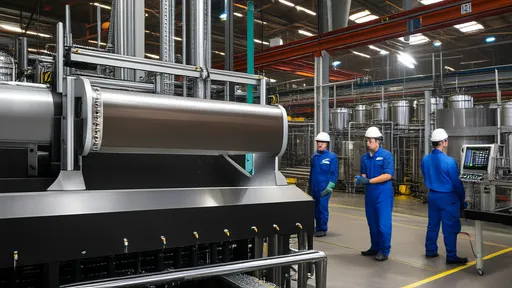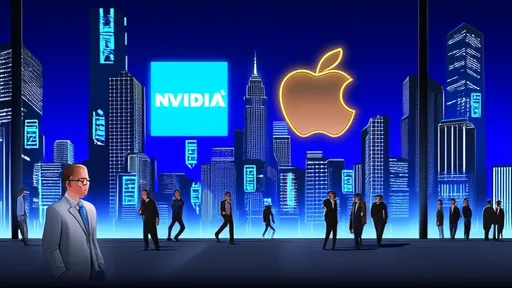The technology world witnessed a seismic shift this week as NVIDIA's market capitalization briefly eclipsed $3 trillion, surpassing Apple to become the second most valuable public company behind Microsoft. This remarkable milestone comes just 18 months after NVIDIA first crossed the $1 trillion valuation mark, highlighting the unprecedented acceleration of demand for artificial intelligence computing power.
NVIDIA's ascent reflects the central role its graphics processing units (GPUs) now play in powering the global AI revolution. The company's chips have become the gold standard for training large language models like ChatGPT and Gemini, with tech giants including Microsoft, Google, Meta, and Amazon collectively spending billions on NVIDIA's latest H100 and upcoming B100 accelerators. This insatiable demand has propelled NVIDIA's data center revenue to $22.6 billion last quarter alone - more than triple its year-ago figure.
The speed of NVIDIA's rise has stunned even seasoned Wall Street analysts. "We've never seen a company scale at this velocity while maintaining such extraordinary profitability," noted Bernstein semiconductor analyst Stacy Rasgon. NVIDIA's gross margins have expanded to 78% despite increased competition, as the company continues to command premium pricing for its AI-optimized chips and accompanying software ecosystem.
What makes NVIDIA's achievement particularly striking is the comparison with Apple. The iPhone maker took nearly 42 years to reach its $3 trillion valuation (first achieved in January 2022), while NVIDIA crossed this threshold just 31 years after its founding. This contrast underscores how AI infrastructure has rapidly become more valuable than consumer hardware in investors' eyes.
However, questions loom about how long NVIDIA can maintain its AI supremacy. The semiconductor industry has historically been cyclical, with technological leadership changing hands multiple times. NVIDIA faces challenges on three fronts: geopolitical tensions affecting its China business, rising competition from custom silicon developed by cloud providers, and the potential for AI workloads to eventually shift toward cheaper alternatives.
The China factor represents perhaps the most immediate concern. US export controls have forced NVIDIA to create downgraded chip versions for the Chinese market, where it previously derived about 20% of revenue. Meanwhile, domestic Chinese firms like Huawei are making rapid progress with alternative AI chips, potentially eroding NVIDIA's position in the world's second-largest economy.
Equally troubling for NVIDIA is the trend of hyperscalers designing their own AI accelerators. Google's TPUs, Amazon's Trainium, and Microsoft's upcoming Athena chips all aim to reduce reliance on NVIDIA's expensive hardware. Meta has even suggested it might deploy over 300,000 in-house developed AI chips this year. While these alternatives currently complement rather than replace NVIDIA GPUs, they signal a long-term threat to the company's pricing power.
Perhaps the most existential question concerns whether AI computing will always require NVIDIA's specialized hardware. Some researchers believe future AI models could become less computationally intensive, while others speculate that quantum computing or optical processors might eventually disrupt the current GPU paradigm. NVIDIA CEO Jensen Huang has dismissed these concerns, arguing that AI's appetite for computing will only grow as models become multimodal.
NVIDIA's software ecosystem may prove to be its most durable advantage. The company's CUDA platform has become the de facto standard for AI development, creating what analysts describe as a "virtuous cycle" - more developers using CUDA leads to more software optimization for NVIDIA hardware, which in turn attracts more developers. This moat has proven difficult for competitors to breach, despite numerous attempts over the past decade.
The company is also rapidly expanding beyond hardware into AI services and robotics platforms. Its Omniverse digital twin technology and AI foundry services represent early bets on how enterprises will deploy AI across industries. These initiatives aim to make NVIDIA indispensable throughout the AI lifecycle rather than just as a component supplier.
Market dynamics suggest NVIDIA's reign may continue in the near term. With AI spending still in its infancy and global data center infrastructure requiring complete overhauls to handle generative AI workloads, demand for NVIDIA's products shows no signs of abating. Wall Street projects the company could generate over $100 billion in revenue this fiscal year - more than AMD, Intel, and Qualcomm combined.
Yet history cautions against declaring permanent victory in the tech sector. Past leaders like Cisco during the dot-com boom or Intel in the PC era eventually saw their dominance challenged as industry architectures evolved. NVIDIA's challenge will be to avoid similar complacency as it navigates the complex interplay of technological change, geopolitical pressures, and shifting customer priorities.
For now, the company shows no signs of slowing down. With its Blackwell GPU architecture set to ship later this year and AI adoption still accelerating across industries, NVIDIA may well have room to grow before reaching its zenith. But as the saying goes in Silicon Valley: "What goes up must come down." The only question is when - and whether NVIDIA can reinvent itself fast enough when that day arrives.

By /Jun 23, 2025

By /Jun 23, 2025

By /Jun 23, 2025

By /Jun 23, 2025

By /Jun 23, 2025

By /Jun 23, 2025

By /Jun 23, 2025

By /Jun 23, 2025

By /Jun 23, 2025

By /Jun 23, 2025

By /Jun 23, 2025

By /Jun 23, 2025

By /Jun 23, 2025

By /Jun 23, 2025

By /Jun 23, 2025

By /Jun 3, 2025

By /Jun 3, 2025